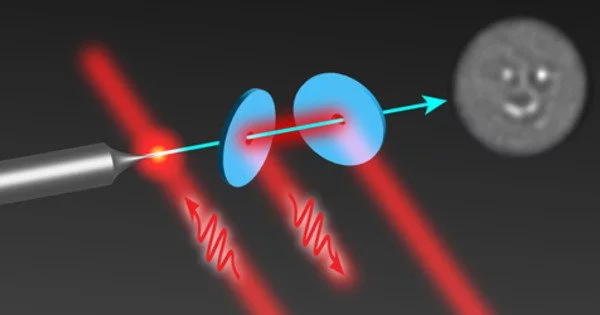While transmission electron microscopes (TEMs) are becoming more accessible due to novel automation, simple software, and reduced space requirements, they can still be intimidating for new users who have never worked with an electron microscope before. They may be surprised to learn, however, that these instruments are very similar to the common light microscope.
A new technique that combines electron microscopy and laser technology allows for programmable, arbitrary electron beam shaping. It has the potential to be used to improve electron optics and adaptive electron microscopy by increasing sensitivity while decreasing beam-induced damage. Researchers at the University of Vienna and the University of Siegen have now demonstrated this fundamental and disruptive technology. The findings have been published in PRX.
Standard imaging technologies suffer significant limitations in imaging quality when light passes through turbulent or dense material, such as the Earth’s atmosphere or a millimeter-thick tissue. Scientists use deformable mirrors in the optical path of a telescope or microscope to cancel out unwanted effects. Many breakthroughs in astronomy and deep-tissue imaging have resulted from these so-called adaptive optics.
We are writing with the laser beam in the transverse phase of the electron wave. Our findings pave the way for wavefront shaping in pulsed electron microscopes with thousands of programmable pixels. In the future, parts of your electron microscope may be made from light.
Marius Constantin Chirita Mihaila
This level of control, however, has not yet been achieved in electron optics, despite the fact that many applications in materials science and structural biology require it. In electron optics, scientists use electron beams rather than light to image structures with atomic resolution. Static electromagnetic fields are typically used to steer and focus electron beams.
In a new study published in PRX, researchers from the University of Vienna (at the Faculty of Physics and the Max Perutz Labs) and the University of Siegen have now shown that it is possible to deflect electron beams almost arbitrarily using high-intensity, shaped light fields, which repel electrons. Kapitza and Dirac first predicted this effect in 1933, and the first experimental demonstrations (Bucksbaum et al., 1988, Freimund et al., 2001) became possible with the advent of high-intensity pulsed lasers.

The Vienna-based experiment now makes use of our ability to shape light. In a modified scanning electron microscope, a spatial light modulator shapes a laser pulse that interacts with a counter-propagating, synchronized pulsed electron beam. This enables the imprinting of transverse phase shifts to the electron wave on demand, allowing for unprecedented control over electron beams.
The potential of this innovative technology is demonstrated by creating convex and concave electron lenses and complex electron intensity distributions. “We are writing with the laser beam in the transverse phase of the electron wave,” said the study’s lead author, Marius Constantin Chirita Mihaila. Our findings pave the way for wavefront shaping in pulsed electron microscopes with thousands of programmable pixels. In the future, parts of your electron microscope may be made from light.”
Unlike competing electron-shaping technologies, the scheme is programmable and avoids losses, inelastic scattering, and instabilities caused by material diffraction element degradation. Thomas Juffmann, the group’s leader at the University of Vienna, adds, “In pulsed electron microscopes, our shaping technique allows for aberration correction and adaptive imaging. It can be used to optimize sensitivity by adjusting your microscope to the specimens you’re studying.”
















